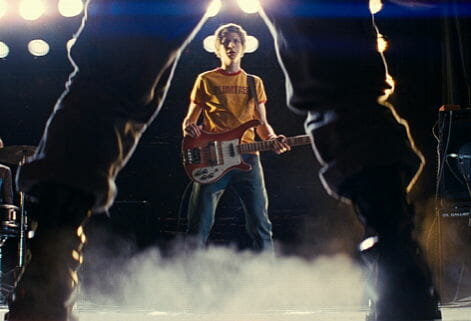By Megan Lane · August 16, 2010

{ga=mlane}As of late, there have been several movies based on graphic novels: Surrogates (2009), Kick-Ass (2010), Wanted (2008), and Watchmen (2009) to name a few. In post-modern Hollywood, studios love source material almost as much as they love international box office returns. However, Scott Pilgrim Vs. the World is the first movie I’ve ever seen that's actually loyal to the graphic novel aesthetic. It actually looks and feels like a living, breathing graphic novel.
Scott Pilgrim Vs. the World follows, you guessed it, Scott Pilgrim (Michael Cera) as he battles seven evil ex-boyfriends in order to win girl of his dreams, Ramona Flowers (Mary Elizabeth Winstead). Throughout his strife-ridden task, Scott's friends, bandmates, roommates, and current high school-aged girlfriend all come to his aid. To elaborate on the plot further would spoil the major fun of the film, so please allow me to hanker on the aesthetics from here on out…
Director Edgar Wright’s action sequences are absolutely fantastic. They looked like video games, complete with characters bursting into coins when they are killed. The action was original, unlike anything I’ve ever seen before, but at the same time, brilliantly reminiscent of early video games. But like early video games, what the film had in action, it lacked in story. Why did Scott have to fight Ramona’s exes to win her heart?
How does he walk away completely unharmed after every fight? And most of all, how is it possible that no one in this world acknowledges that these super human fights are occurring. I know Toronto is a weird place (the setting of the film), but it’s not that weird.
In a movie that involves so much suspension of disbelief in such a fantastic world, it is important to at least believe in the characters. Suffice it to say, this film lacked good characters. It is not an original argument for me to state that Michael Cera was once again playing George Michael Bluth, his now somewhat iconic character from the late, great Arrested Development. He was the shy, unsure ofhimself, quiet spoken man-child that he's portrayed Superbad (2007) and Juno (2007). Please, Michael – show us something new.
On top of being completely spineless (a la Cera's above mentioned repertoire), Scott Pilgrim totally lacks passion. He has no job, shares a studio apartment, and uses a pay phone more times than you and I have seen in ten years. It’s no secret that we like characters who are good at what they do. What did Scott do? Nothing. One might think that his passion is his band, but (SPOILER ALERT!) at the end he actually gives up his band place to fight for Ramona. What does Scott care about? And if your answer is, “the girl he’s known for a week and a half”, that’s not good enough.
Speaking of this whimsical girl he’s known for a week and a half, I can't help but think, "what is so special about Ramona Flowers?" As I see it now, the only thing special about her is that she dyes her hair a different color every week and a half. May I just say that I’m sick of girls who are mysterious and quirky only for the sake of being mysterious and quirky and expressing that through awkward hair choices. It stopped being original after Eternal Sunshine of the Spotless Mind (2004). Anyway, this just reinforces the totally flat range of the film's characters in general.
The one character that shined through was Wallace Wells (Kieran Culkin), Scott’s gay roommate. This film marks the return of Kieran Culkin. He hasn’t been this funny since guzzling soda and wetting the bed in Home Alone (1990). I see bright things in his future.
Ultimately, Scott Pilgrim Vs. the World looked cool. It was an epic of epic epicness (which is definitely the most rockin’ tagline I’ve ever heard), but it was missing the elements that separate a film from a video game, namely story and characters.
2 out of 4 cool ideas that don't pan out.